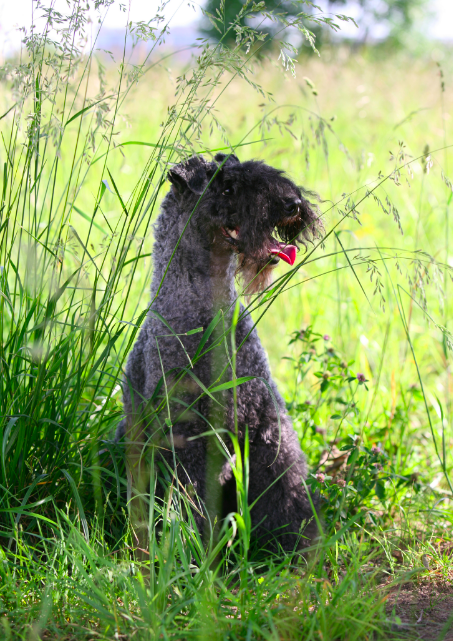
Hay fever is a type of inflammation which occurs when the immune system overreacts to allergens in the air. Hay fever (or Allergic rhinitis) is typically triggered by environmental allergens such as pollen, pet hair, dust or mold. The condition can make feel people who are prone to it feel really miserable. But did you know dogs (and cats) can suffer from hay fever too? However, their immune systems are not the same as ours, so sneezing and runny noses aren’t usually the presenting symptoms. Pets with hay fever are often very itchy all over their bodies. The most commonly affected areas of the skin include the armpits, the groin, the base of the tail, the feet and the sides of the face. Signs of canine hay fever involve:
• Itching and scratching
• Bold spots
• Rash on the face and paws
• Redness
• Ear infections
• Scabs and lumps in the skin
Hay fever is a seasonal allergy, so the greatest problems will be during the summer and early fall. Some dog breeds seem to be particularly prone to hay fever, including terriers, poodles, schnauzers and the Dalmatian. Like humans, dogs can develop hay fever at any age although symptoms often begin when dogs are 1 to 3 years old. It can be difficult to figure out what’s causing your dog’s allergies, since the symptoms of hay fever are similar to many other things. Your vet can do allergy testing to identify if hay fever is indeed causing the problem.
CAN CANINE HAY FEVER BE TREATED?
With hay fever it’s not possible to remove the source of the allergy and unfortunately there is no cure for it. But there are a few things you can do for your dog to make him feel better:
• Keep your dog indoors as much as possible on days when pollen counts are high, especially on windy days.
• Wash your dog’s bedding weekly with hot water and vacuum regularly to remove the pollen your dog picked up during walks.
• Choose the areas where you walk your dog carefully, keeping him away from longer grass and vegetation.
• Wipe your dog’s coat over with a damp towel immediately after a walk to remove any pollen. Start with the face and end with the legs and paws (your dog may have been running on grass, coming into direct contact with pollen).
• Boost your dog’s immune system. By improving the general health of your dog allergic reactions can be helped. Make sure your dog has a healthy weight and a balanced diet.
• Give your dog oatmeal baths frequently to sooth the skin and remove pollen. Oatmeal can give your dog temporarily relief from dry and itchy skin. Just poor one cup crushed whole oatmeal in a tub and stir. You can also use an oatmeal shampoo for dogs or other shampoo’s designed to reduce skin problems (although not so frequently that it dries out the skin).
• For the rare cases where pollen allergy does provoke sneezing and runny eyes, eye and nose drops supplied by the vet can be effective.
If none of the mentioned treatments prove effective, your dog might be a candidate for hay fever medication or allergy shots. Consult your vet for further information.

sources: www.vetinfo.com, www.pets4homes.co.uk, www.kingsteigntonvetgroup.co.uk, www.selfselectionforanimals.co.uk
This entry was posted in Dogs on July 4th, 2018 by helenkennedy

Rocky is a Medical Alert Assistance Dog and a fantastic companion for 7 year old Josh who has unexplained hypoglycemia and Epilepsy and has had many hospital stays since he was born. Rocky has been trained by the Medical Detection Dogs charity to alert Josh’s family when his blood sugars drop dangerously low and could trigger a seizure.
We spoke to Josh’s mum Paula to find our more about this delightful friendship!
What type of dog is Rocky? He’s a Cockapoo
How old is he? He’ll be 2 on the 28th September. He joined our family when he was 9 weeks old.
What does Rocky do to help Josh on a daily basis?
Rocky spends all his time with Josh and alerts us when his blood sugars drop too low by sense of smell. Josh has unexplained hypoglycemia along with epilepsy and his seizures can be triggered by low blood sugar. We test Josh’s blood sugar numerous times a day but are extremely lucky to have Rocky with us who has alerted us many times when his blood sugars drop to a dangerous level which has fortunately stopped things escalating to a medical emergency. Rocky sleeps in Josh’s room and we are confident he will come and wake us if he ever senses a problem.
If Rocky wants to alert Josh, he stands on his back legs and puts his paws on Josh’s shoulder and licks his face. If Josh is asleep he comes to find me and licks my hands to wake me.
Did the Medical Detection Dog Charity advise you about what type of dog to get? We had spoken with the charity prior to buying Rocky and knew what to look for when looking for a puppy to give us the best possible chance of buying a puppy that we may be able to train successfully. Obviously we knew there were no guarantees on this and also looked for a puppy we thought would be the ‘best fit’ as our new family member.
Did you have to crate train him or was he already crate trained when you got him? We chose to crate train. He was used to a crate from being with Mum so it was very straight forward. He took his blanket in with him and was always happy. The training we did with Rocky with the crate was very easy, primarily due to him already being used to one.
During Rocky’s Medical Detection Dog training did you have to attend lots of classes? Rocky and I used to have one to one training on a weekly basis. Josh attended the training whenever possible. I would also send off any records of alerting behaviours along with all of Josh’s blood sugar recordings.
What did the training include? Where was the training held? The training was held at a variety of places. It included public access, off lead walking, heal work, distraction work etc etc. We had a train trip, a bus trip, taxi ride, public access – so inside shops, supermarkets etc, in school, busy places and quieter places, all to see how Rocky would react. And of course, a vet visit.
How long did the training take from start to finish? Rocky qualified at 18 months of age. The youngest possible age to qualify. We were training with him from the moment he came home at 9 weeks of age.
Do you have to go for additional training even now he has qualified? We have a first post qualification check 6 months from qualification and then every 12 months after. If we come across any problems at all at any point, we are fully encouraged to speak with MDD for full support wherever it is needed. We will also attend regular refresher training to ensure Rocky maintains his high standard of behaviour and alerting.
What type of treats do you feed Rocky as a reward? Rocky always has the same reward, dehydrated hotdog sausage – his absolute favourite!
Is Rocky allowed to go everywhere with Josh?
Yes he is. Rocky has to wear his ‘Medical Alert Assistance Dog’ tabbard whenever we are out in public and is allowed in all public access areas including shops, restaurants, beaches and cinemas.
Rocky and Josh are best friends. Josh trusts Rocky completely and understands that he helps to keep him safe. Rocky is simply a life changing member of our family.
—————————–
Medical Detection Dogs is a fabulous charity that trains dogs to detect the odour of human disease. It is at the forefront of the research into the fight against cancer and helping people with life-threatening diseases. To find out more about the amazing work that they do click here
If you are looking to crate train your dog, click here to find out more about the Fido Studio Dog Crate
This entry was posted in Dogs on July 4th, 2018 by helenkennedy

Many of us would agree that there are few things nicer on a hot summer’s day than a trip to the beach, and as long as you come prepared there is no reason to leave your pooch at home. Swimming is one of the best forms of exercise for dogs, and you can stay as long as you like without having to worry about getting home to let the dog out!
There are however a few things you need to do before you leave, and some things that are good to know when it comes to dogs and the beach. Here are our best tips for a successful outing!
Find a dog-friendly beach
Dogs are not always allowed on public beaches, but there is normally an area close-by where you can take your dog. Search for a dog-friendly beach nearby, read up on the rules, and make sure you follow them!
Keep an eye on your dog

Even if you’re at a dog-friendly beach you must always keep an eye on your dog, and show consideration to the other beach goers and dog owners. No one appreciates being sprayed with water from a wet dog as they’re relaxing with a good book! If you’re not absolutely sure your dog will come when you call or stay close to you, it might be best to keep it on the lead.
You also have to make sure your dog stays safe at the beach. Dogs are amazing at finding things in the sand that might not be good for them, everything from leftover barbecue ingredients to rotting fish. Glass, sharp shells, or even old fish hooks may hide in the sand, and can hurt your dog’s precious paws.
Teach your dog to swim
Many believe that all dogs know how to swim, but that is not the case. Even if all dogs will automatically paddle their feet if you put them in the water, there are several dog breeds that aren’t built to stay floating. Breeds with large heads and short legs will struggle to keep their head over the surface to breathe. If your dog seems to love swimming but you’re not completely sure about their ability, it might be a good idea to invest in a doggy life jacket.
That being said, there are lots of dogs that don’t really enjoy the water, or who will be perfectly happy running around in the shallow parts where they don’t have to swim. Never force a dog to come swimming with you!
Even if your dog is a strong swimmer, it’s important for you as an owner to keep an eye on them as they’re out in the water. Make sure you stay informed about currents in the water, and don’t let the dog in if there are high waves or lots of boats or jet skis around. Dogs can easily get too excited in the water and swim out into deep waters, where the current might be much stronger. You also have to supervise dogs playing and swimming with children.
Come prepared

Make sure you pack everything you need for a day at the beach. Dogs will need plenty of fresh water, so get enough for the whole family. It’s a good idea to have a collapsible water bowl, so you don’t have to make your dog drink straight from the bottle. This way you can also keep track of how much water the dog has actually had.
Bring toys that will entertain your dog throughout the day. If you’re able to throw balls or other toys down the beach, that is a perfect activity that will entertain your dogs, and give it a good amount of exercise. Just make sure the toys float if they end up in the water.
If you’re staying at the beach for a few hours, or maybe even the whole day, it’s important to make sure the dog can get some shade. If you’re not sure whether there are shaded areas where you’re going or not, bring a parasol or a small beach tent where the dog can relax during the hottest hours of the day.
Before you leave
Make sure you leave nothing behind, and clean up after yourself and your dog!
If there are taps or beach showers where you are, you might want to rinse your dog before you leave for the day. Salt can cause irritation to the dog’s skin, and sand can get in their eyes as they’re trying to get rid of it from their faces, which can cause eye infections and lots of discomfort. The dog will probably also have been exposed to plenty of dirt and bacteria during all the exploring.
If you can’t find any fresh water at the beach, it might be a good idea to scrub your dog with a towel before you get in the car (maybe mainly to not end up with a desert in the boot), and then give him or her a quick bath when you get home.

This entry was posted in Dogs on July 4th, 2018 by helenkennedy

1)
Rabbit teeth never stop growing and it is very important to keep a regular check on them. Rabbits have 28 teeth. Some signs of overgrown teeth are lack of appetite, listlessness and weight loss. Always seek expert advice about this.
2)
Rabbits live for between 4 – 8 years. Giant Rabbits generally live shorter lives – approx 4 -5 years. Dwarf breeds have a longer life span and can live for as long as eight years and in some rare cases, it has been documented, for even longer.
3)
Rabbits’ eyes are on the sides of the head, giving them excellent vision all the way around, with a small blind spot at the point directly in front of them and directly behind them. As prey animals, this trait enables them to keep a lookout for predators.
4)
Rabbits cannot sweat. They release heat over their body surface, especially the ears.
5)
Rabbits have 5 toes on each front paw and 4 toes on each hind paw, so 18 total.
6)
A Rabbit’s pregnancy lasts 28-31 days and an average litter has 6-10 babies.
7)
A female Rabbit is called a doe
A male Rabbit is called a buck.
A young Rabbit is called a kit (or kitten)
8)
Baby Rabbits are born with their eyes closed, and the eyes do not begin to open until around the age of two weeks old.
9)
More than half of the world’s rabbits live in North America.
10)
Rabbits are crepuscular which means they snooze all day and are most active in the early morning and in the evening.
11)
When a rabbit is very happy, it jumps up into the air, twisting and flicking its feet and head. This movement is known as a binky!
12)
Rabbits chew 120 times a minute and have over 17,000 taste buds.
This entry was posted in Rabbits on July 3rd, 2018 by helenkennedy










